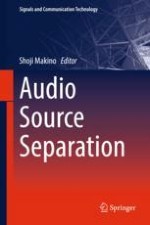2018 | OriginalPaper | Buchkapitel
6. Determined Blind Source Separation with Independent Low-Rank Matrix Analysis
verfasst von : Daichi Kitamura, Nobutaka Ono, Hiroshi Sawada, Hirokazu Kameoka, Hiroshi Saruwatari
Erschienen in: Audio Source Separation
Aktivieren Sie unsere intelligente Suche, um passende Fachinhalte oder Patente zu finden.
Wählen Sie Textabschnitte aus um mit Künstlicher Intelligenz passenden Patente zu finden. powered by
Markieren Sie Textabschnitte, um KI-gestützt weitere passende Inhalte zu finden. powered by
